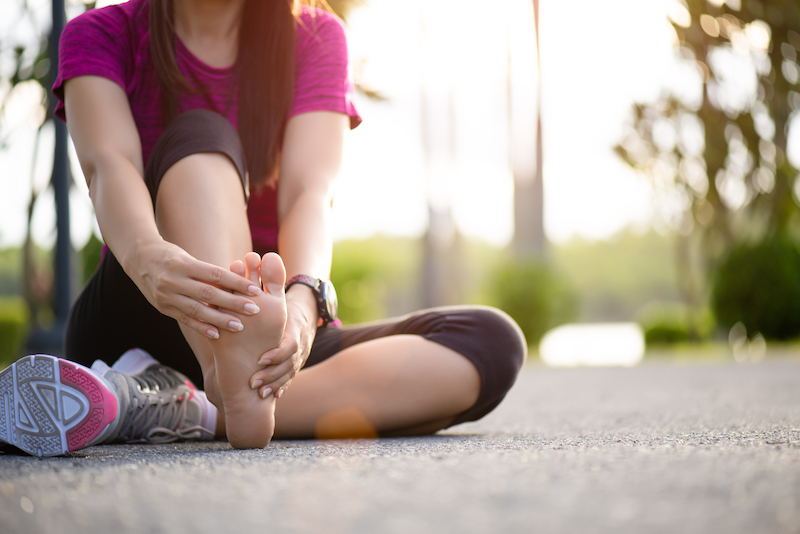
If you’ve ever experienced athlete’s foot, you know firsthand how uncomfortable and inconvenient it can be. The itching, flaking, red and/or fissured skin can make it difficult to focus on anything else, and it’s hard to feel confident and comfortable when your feet are causing you discomfort or look unsightly. If you’re an active person who enjoys sports or outdoor activities, athlete’s foot can be even more frustrating. But the good news is that with proper treatment and prevention measures, you can take control of your athlete’s foot and prevent it from interfering with your daily life.
Athlete’s Foot: The Basics and Causes
Athlete’s foot, or tinea pedis (tinea is the medical term for fungus, while pedis is the Latin word for ‘of the foot’) is a fungal infection caused by so-called dermatophytes, mostly a species named trichophyton rubrum. The condition typically occurs between the toes, as the fungus responsible thrives in warm, moist, and airless environments, making the space between your toes an ideal breeding ground.
Symptoms include itchy, red, scaly, dry, cracked, or blistered skin. If left untreated, the infection can spread to the toenails and cause complications such as yellow discoloration, thickening of the nail, and a crumbly nail plate. This fungal infection of the toe nails, also known as onychomycosis, is very common and treatable, but much more difficult and lengthy to clear than a simple fungal infection between your toes. That’s why it’s very important to get tinea pedis treated early, so it doesn’t spread and cause more complicated issues.
The fungus is highly contagious and can be picked up from contaminated surfaces like gym floors, locker rooms, swimming pools, steam rooms, and public or hotel showers, making it essential to take precautions in these environments.
The Underwear Connection: How Athlete’s Foot Can Spread to Your Genitals
You might be surprised to learn that athlete’s foot can not only spread to your toe nails, but also to your genitals – thanks to your underwear. The fungus can be transferred both through scratching the infected area and then touching other parts of your body, or via contaminated objects like towels or socks. In addition, when you step into your underwear, fungal elements from your infected feet may stick to the fabric and be pulled up into your groin area. Understanding this possible connection is crucial in preventing the spread of the infection and maintaining good hygiene.
Tinea Cruris: Recognizing Jock Itch
Once athlete’s foot fungus spreads to your groin, it takes on a new identity: tinea cruris, also known as ‘jock itch’ (the term ‘cruris’ comes from the Latin word for ‘of the leg’).
This infection presents with symptoms such as itchiness (often starting in skin creases, where the moist and warm environment provides optimal conditions for the fungus to grow), a red rash with a sharp (often even accentuate) border between affected and healthy skin. From the skin creases of your groin it can potentially spread down the inside of the thighs or other skin areas.
Diagnosing and Treating Fungal Infections Of The Skin
To treat tinea (ie fungal infection of the skin), whatever area it affects, you’ll first need a proper diagnosis from a doctor (ideally a dermatologist!). The diagnosis can often be made by experts such as dermatologists through simple visual examination of the skin (this is called a clinical diagnosis), but on occasion will need a lab investigation to confirm the suspected clinical diagnosis. For this a (painless) skin scraping is taken from the affected area, which is then submitted to the lab for either a fungal culture (which means trying to grow the fungus on a test plate in the lab) or a fungal PCR (the latter detects the fungus via amplified DNA segments).
After diagnosis your doctor will likely prescribe an antifungal cream with active ingredients such as terbinafine, clotrimazole, econazole, ketoconazole, or miconazole. Applying the cream regularly twice daily to the rash and surrounding normal skin is crucial for effective treatment. It’s also important to not stop treatment early, but complete the entire course duration as recommended by your doctor, rather than stopping as soon as the itch feels better, as this may lead to recurrence.
If the toe nails are affected, you may be prescribed a special, anti-fungal nail lacquer to be applied a few times per week or daily. Treatment of toenails will take much longer than treatment of skin, as you will have to continue until the affected nail has completely grown out, which can take months. Stopping treatment before the entirety of the affected nail has grown out, will lead to recurrence. This is a common mistake that both patients and doctors make.
In severe or more widespread cases, antifungal tablets may be prescribed instead of a cream or nail lacquer. Remember to follow your dermatologist’s instructions and complete the full treatment course, even if the symptoms appear to have cleared. For skin, this may be just 2-4 weeks, but in the case of toe nails it means taking the tablets until the newly grown nail has completely replaced the diseased nail, which can be many months or even a year, if the entire nail plate is infected. For longterm anti-fungal tablet treatment (in the case of toe nails) we perform intermittent blood checks to make sure your body is tolerating the tablets well.
As a general rule, nail lacquers are only likely to be effective if less than a third of the nail plate is infected. If the fungus has invaded more than a third of the nail, you will likely need tablet treatment.
The good news is that for fungal toe nail infections, we have an effective laser treatment available at Eudelo, which can clear your nails in just a few sittings, without the need for lengthy systemic treatment or blood checks.
Lifestyle Changes to Minimize the Risk of Fungal Infection
Making a few lifestyle changes can greatly reduce your risk of developing athlete’s foot or jock itch. Firstly, keep your feet dry by wearing breathable fabrics or moisture-wicking socks, and shoes made of breathable materials. The name of the game is to avoid moist or humid skin environments, which the fungus loves.
If you’re prone to sweaty feet, consider sweat reducing treatments such as anti-persirant roll-ons or iontophoresis, which is an effective treatment for hyperhidrosis (ie sweat overproduction).
When using public facilities like gyms, pools, steam rooms, saunas and hotels (although one would hope that hotel shower basins and floors are cleaned properly…), always wear (your own!) flip-flops or shower shoes to protect your feet from potentially contaminated surfaces.
Additionally, maintaining a strong immune system through a healthy diet, regular exercise, and sufficient sleep can help your body fight off infections more effectively.
Other Preventive Measures and Tips for Healthy Skin
To reduce the risk of tinea pedis or cruris, also follow these practical tips:
1. Check your skin regularly (including between your toes!) and consult a dermatologist if you notice anything unusual, which may just be a little crack (fissure) between your toes.
2. Change underwear and socks daily and wash them at high temperatures (95°C), or add an antimicrobial washing powder if that’s not possible.
3. Alternate between two pairs of shoes, allowing one pair to dry out completely before wearing it again.
4. Cleanse your skin daily, paying close attention to areas like the groins and between your toes.
5. Dry your skin thoroughly after showering, especially between your toes. A hairdryer can be helpful for drying hairy groins.
6. Don’t share towels or other contact fabrics with others, and wash them frequently at high temperatures (95°C) or add an antimicrobial washing powder if that’s not possible.
7. If you’re treating a fungal skin infection, avoid re-infecting your skin (‘pin-pong-effect’, where you successfully treat your skin, but you then catch the fungus back from fabrics or surfaces that harbor them). For this reason, you should make sure to wash any contact fabrics such) by washing socks and other contact fabrics including bed linen and shower matts on a hot cycle (or with antiseptic washing powder), and using antifungal spray on shoes. Furthermore, make sure to sanitize potential contact surfaces such as shower basins and bathroom flooring.
8. If you suffer with athlete’s foot, pay attention to how you put on your underpants, ideally avoiding contact of the fabric with your feet when you step into them.
9. If you are prone to fungal infections, you may consider using an antifungal skin powder intermittently as a preventative measure – make sure to discuss this with your doctor, ideally a dermatologist.
By understanding the link between athlete’s foot and jock itch (having said that, tinea cruris can also develop independently!), you can take proactive steps to prevent and treat these uncomfortable skin infections. Follow the guidelines and lifestyle changes mentioned above, and you’ll be well on your way to keeping your skin healthy, free from fungal infections, and comfortable.
Remember, if you suspect that you have athlete’s foot or jock itch, consult a dermatologist for a proper diagnosis and treatment plan. Early intervention is key to preventing the infection from worsening and spreading to other areas of your body.
If you have any concerns about your skin, call Eudelo on 0207 118 9500 – we are here to help!
Whether you have a medical skin condition which needs treatment or simply want to look your very best, our specialised dermatology team will help you achieve the very best result.

